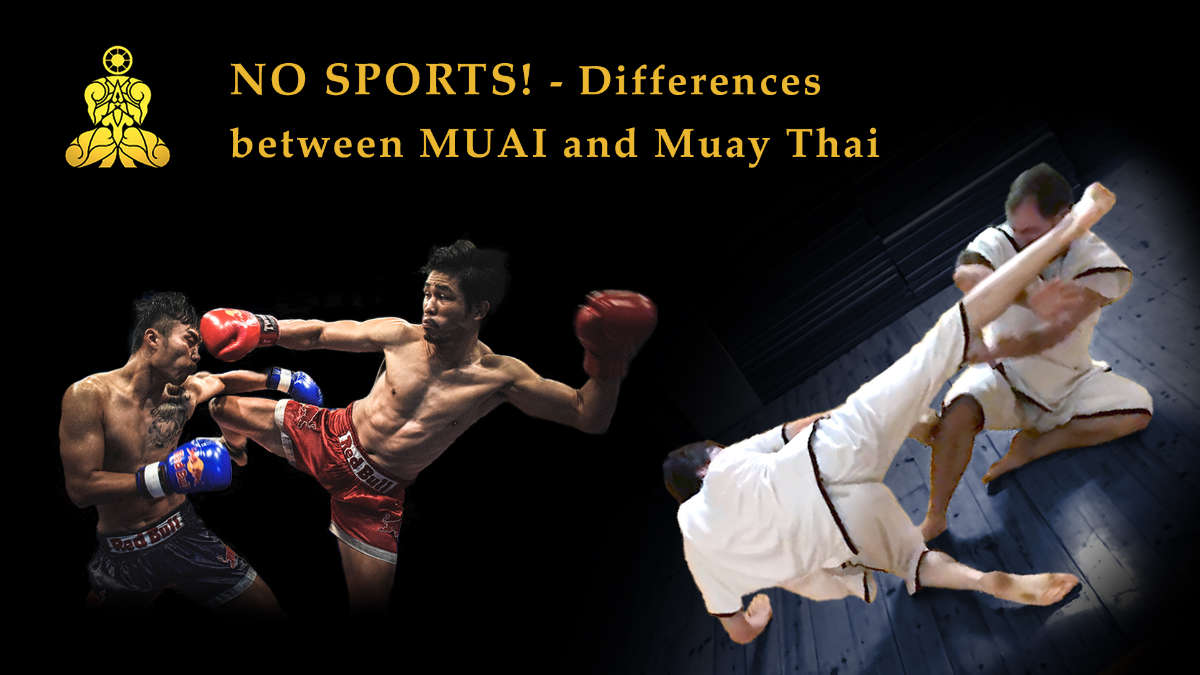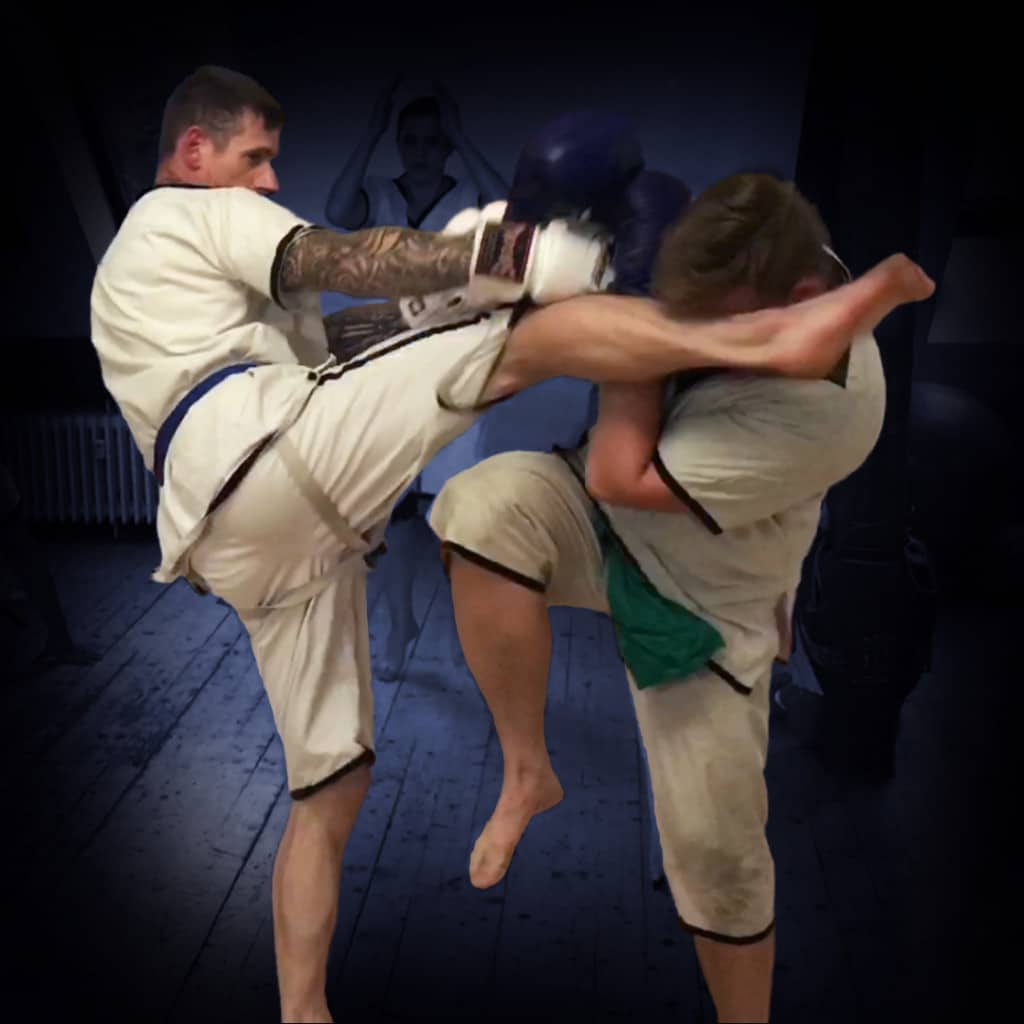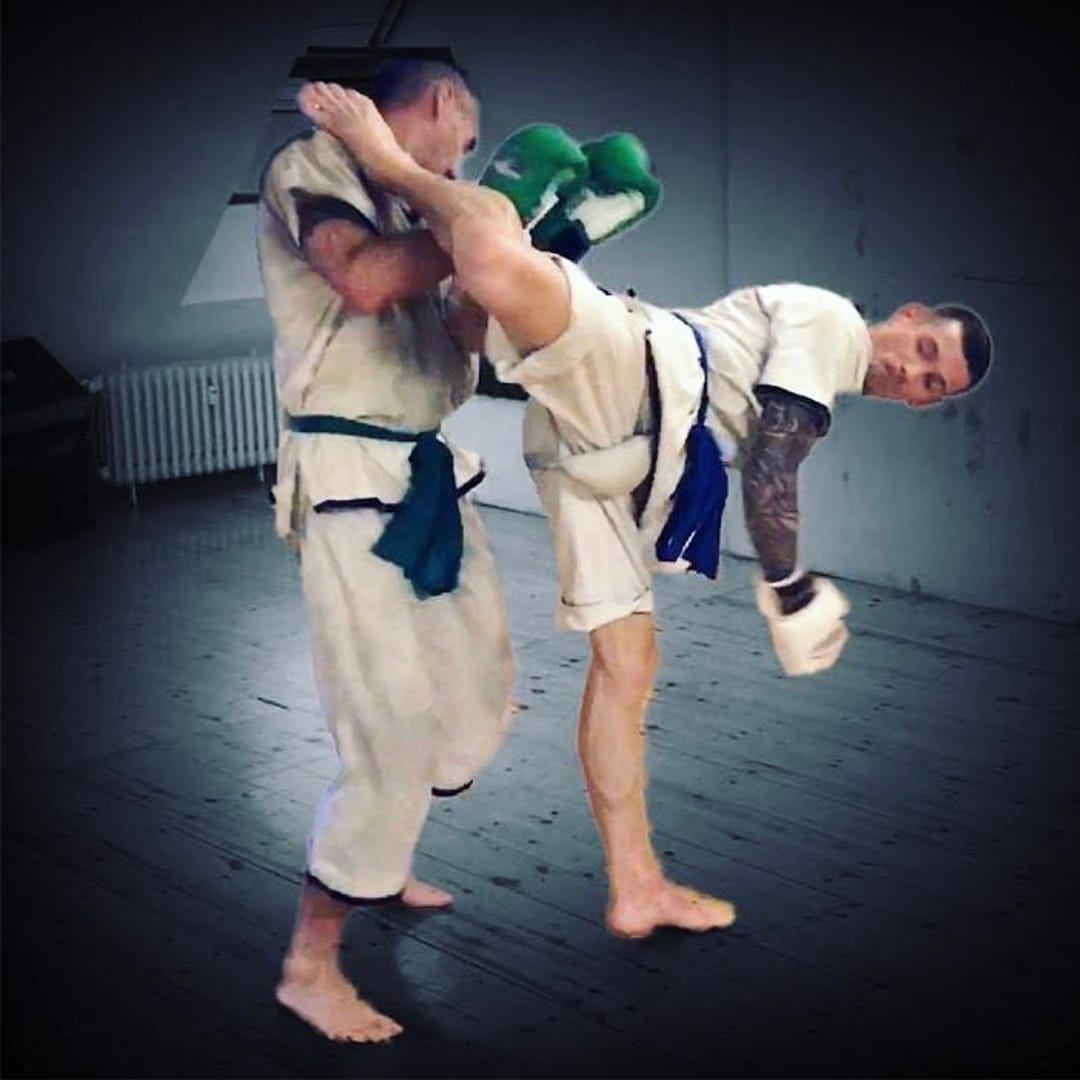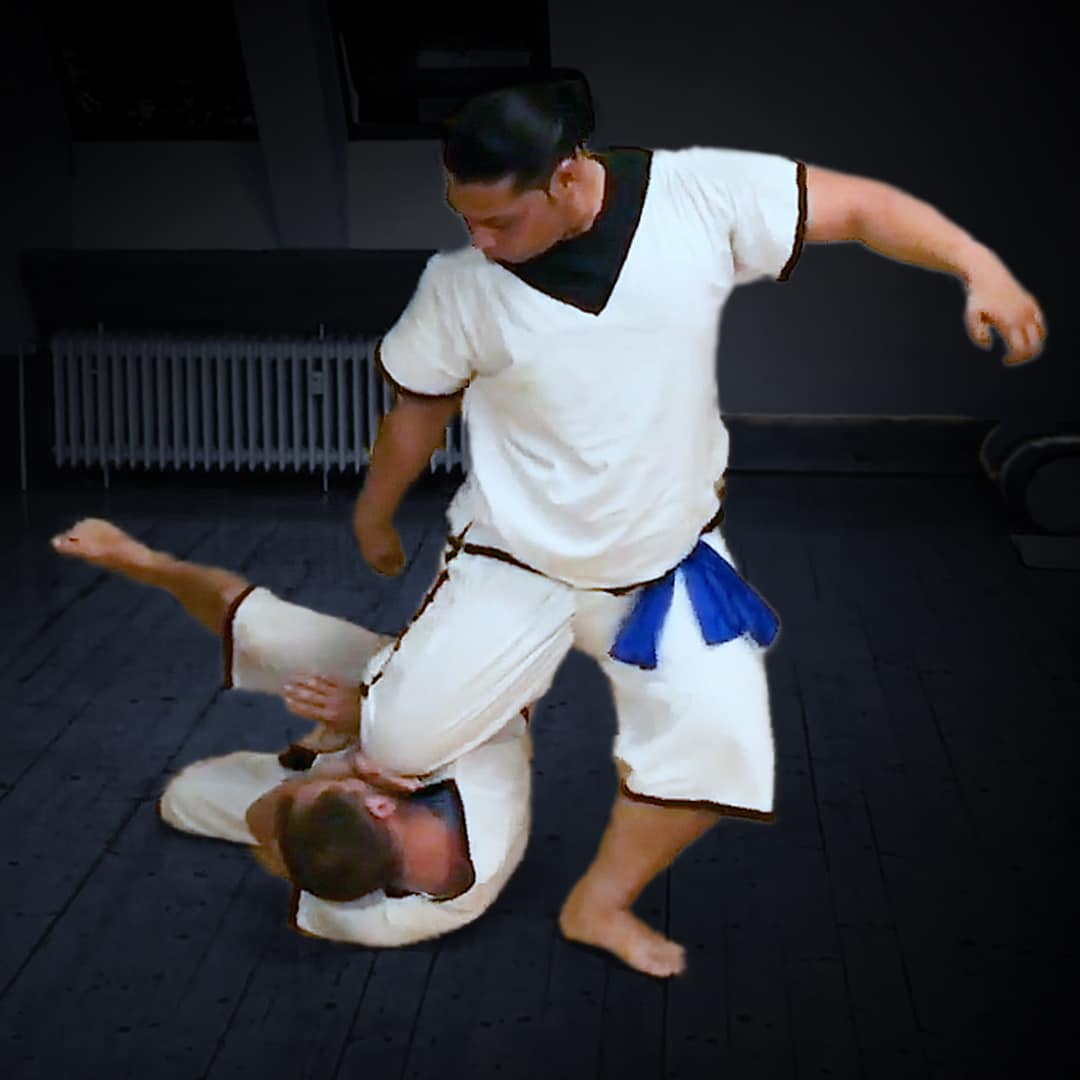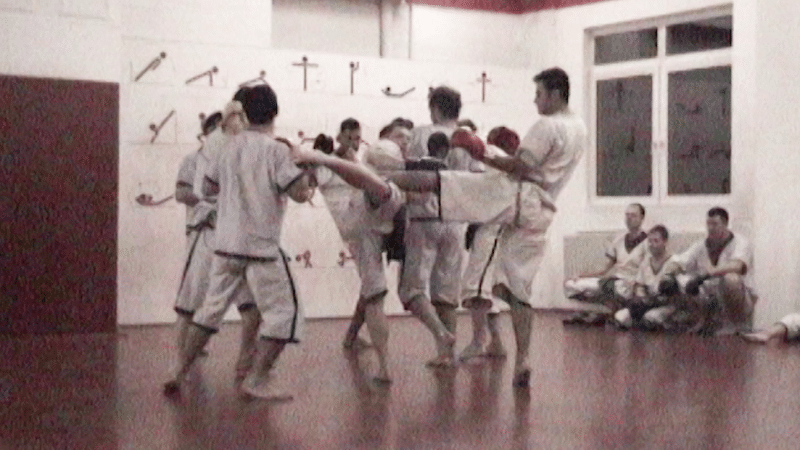Content
No sports – The differences between MUAI and Muay Thai
We are often asked where the differences between MUAI and the Thai national sport Muay Thai (Thaiboxing or Muay Veti) are located. Here are some key points:
MUAI
In order to survive in times of peace, Pahuyuth Free-Warriors held improvisational fights with punches, kicks, elbows and knees from about 900 AD. This resulted in a new fighting method called MUAI, which later became the Thai national sport Muay Thai (Thai boxing) and other Southeast Asian fighting styles (e.g. Bokator, Pradal Serey, Lethwei or Muay Lao).
MUAI was brought back into the Pahuyuth by the Free-Warriors and passed on unadulterated over many generations. Unlike Muay Boran, which was developed in the 1990s, it still has the full technical spectrum and a uniform teaching system with a clear conceptual core.
Since 1975, MUAI has been taught at the Pahuyuth School (then Muai-Thai Studio). It was the first school in Germany to the then unknown “Thai fighting” public and is regarded as an important pioneer for the development of Thai martial arts in Europe, as well as as a benchmark pioneer and authority for traditional Thai martial arts.
No sports – no rules, no fair play
MUAI comes from a time when there were no sports federations, clubs or rules of the fight. Accordingly, MUAI is not a sport or martial arts in the conventional sense. This means that it does not submit to any sporting rules and pretty much any kind of “unsportsmanlike behaviour” and “unfair tricks” are allowed here.
Bare Knuckle Boxing
The MUAI also fights with fist, foot, elbow and knee. However, this is done without dental protection, mouthguard, head protection, chest protection or shin guards. The same applies to boxing gloves and handwraps, which are usually not at hand in the streets and in emergency situations.
MUAI beginners are therefore only granted light gloves (8oz.). Advanced students (from white belt) usually train bare-knuckle (with bare fists).
This form of training requires greater caution than would be the case with gloves and protective equipment. This enables to make use of smaller gaps and narrower angles. This trains the aiming and the defense skills alike. Hiding behind large boxing gloves or lingering behind the double guard is rather difficult without gloves.
Bare-knuckle – without gloves other technical variants are possible.
Ground combat and grappling
Advanced students (from white belt) also train using grip techniques and ground combat elements from LING LOM.
Experienced MUAI practitioners switch seamlessly from standing combat to ground combat and back. The whole thing, of course, without mats and, if necessary, also on urban concrete. Foot sweeps and throwing techniques are known in MUAI. However, they have far less effect here than with pure standing combat systems. Falling and rolling techniques are part of the basic training in Pahuyuth (and thus also in MUAI).
The absence of gloves and bandages allows MUAI practitioners to grab their counterparts and to use grip techniques. However, tactics like longer-term clining, submission grappling or ground-and-pound attacks, as commonly used in MMA (mixed martial arts) are usually avoided. This is due to focus of MUAI on combat situations with multiple opponents.
No shin guards, no headgear, no dental guards, …
In MUAI ancient techniques have been preserved.
Bare-Knuckle – MUAI fights without gloves and hand wraps
Penalty kick – head stomping is part of everyday life at MUAI.
MUAI continues to fight on the ground – there is no referee.
Fighting multiple opponents
Right from the start, MUAI students learn to fight against multiple opponents, which is probably one of the clearest differences from most martial arts.
While in a fair contest one can expect a 1-on-1 situation in most cases, Pahuyuth-Warriors on the battlefield have always faced a multitude of opponents from all directions. While most MUAI practitioners will no longer have to fight on battlefields, it is almost essential for modern self-defense and self-defense purposes to master this facet of combat.
In order to be able to achieve this, MUAI students already learn 200 basic techniques in the beginner level (green belt), which are further supplemented, varied, refined, specialized and further developed in subsequent stages of learning. If one adds the 45 basic techniques of the yellow belt stage, this results in at least 245 techniques, which provide a suitable answer for pretty much every situation that arises.
In addition, MUAI practitioners know no difference between the normal stance (orthodox) and the mirrored stance (southpaw). All MUAI students are always trained to become switch-hitters (both sides), which takes much longer but brings many advantages for the scope of the MUAI.
Pack Boxing – Fighting against multiple opponents has always been part of the MUAI training program.
armed combat
MUAI does not include a armed combat per se. However, it belongs to the Pahuyuth, in which five out of seven disciplines (>70%) deal with armed combat.
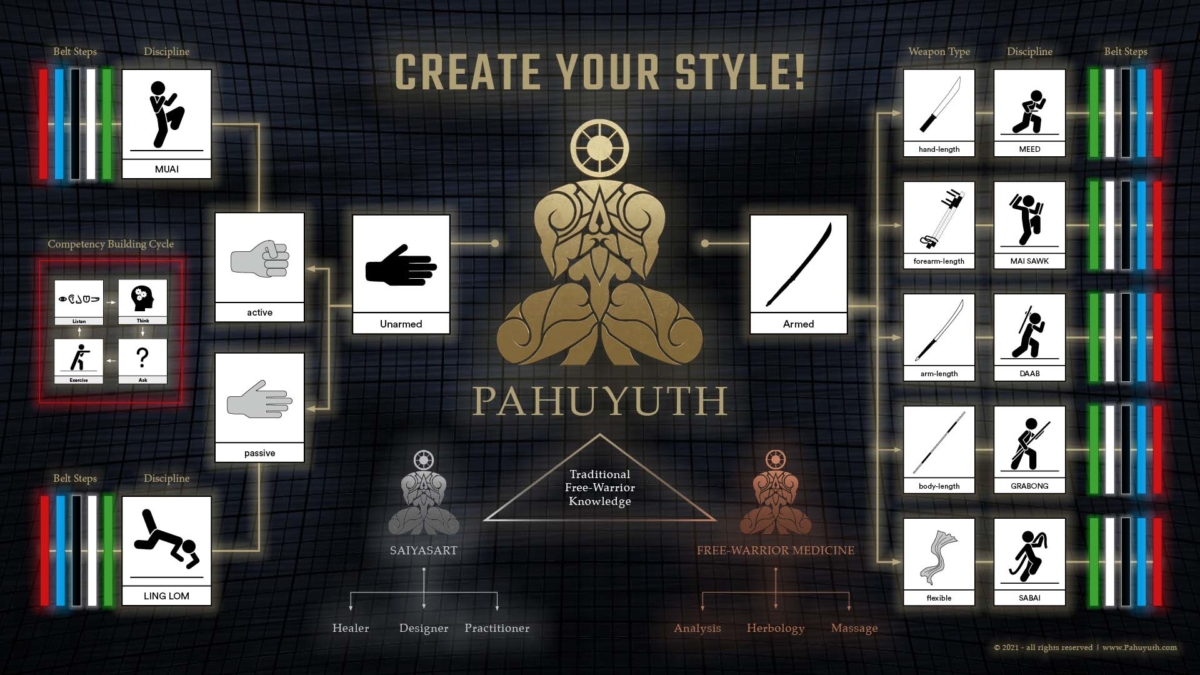
In fact, the MUAI techniques (and thus the Muay Thai techniques) are originally based on armed combat techniques. For example, fist techniques derive from sword or knife fighting (DAAB, MEED), while many kicks and knee techniques are attributed to the staff fighters (Grabong).
This connection is probably most clearly recognizable in shield fighting (MAI SAWK), where fist and elbow techniques can be performed with and without weapons.
Unlike, for example, the Krabi Krabong, all Pahuyuth armed combat disciplines always include techniques of unarmed combat.
On the one hand, this offers a higher range of possibilities (e.g. a combination of sword strikes and punches). On the other hand, pahuyuth also ensures that warriors can continue to fight seamlessly if their weapons are lost. As mentiones before, there is no referee.
Teacher-student relationship
Another significant cultural difference is the teacher-student relationship.
In Thai culture, a teacher (Kru) receives the greatest respect and is revered both publicly and privately. In many cases, this creates a form of adoration and glorification from which a form of hierarchy arises in social life.
In the culture of the Pahuyuth Free-Warriors all human beings are equal. It follows that a MUAI teacher (Kru) is always an experienced warrior and respected bearer of knowledge, but never a ruler or master.
For this reason, the traditional Wai Kru (teacher’s greeting) is never performed in honor of a living teacher.
Wai Kru Ram Muai
The ritual dances known in Muay Veti (Muay Thai), performed before each fight, were originally invented by Pahuyuth Free-Warriors.
Until 2018 (A.D.) there were still various Ram Muai choreographies in the official curriculum of the discipline MUAI.
Why we will not continue this tradition and what this decision means for future MUAI students, we explain in a separate blog article.
No competitions, no competition preparation
In principle, every MUAI student is free to participate in sports competitions at his own discretion. Within Pahuyuth, however, there is no competition-oriented training and therefore no sports competition promotion.
The creation of sports federations or participation in such a sport would always lead to a restriction by sporting and social rules. This does not correspond to the culture of the Pahuyuth Free-Warriors which is based on the rebellion against oppression and slavery and the quest for peace and freedom.
Therefore, while the modern Muay Veti (Muay Thai) has incorporated decades of industrial development, specialization and selection for sports competitions as well as state-of-the-art knowledge of sports and nutrition sciences, traditional MUAI training has always aimed at the widest possible range of applications and maximum individual freedom.
So if there is something that MUAI can’t or doesn’t do well and usually doesn’t want to, then it’s fighting limited by the rules of Muay Veti (Muay Thai) or any other sport. For this purpose, there are specialists who can master this particular type of fighting much better and therefore offer a much better training in this particular sport.
Muay Veti (Muay Thai)
Unlike MUAI, Muay Veti (aka. Muay Thai or Thai boxing) is designed exclusively for a sporting competition between two opponents standing, although the scope of the permitted techniques has shrunk further and further in the course of the development and industrialization of Muay Thai.
Betting and betting businesses have always been an essential part of Southeast Asian culture. It is therefore not surprising that the outcome of fights between human adversaries has been and will be wagered.
The modern Muay Veti (Muay Thai) was created around 1910 (A.D.) when a Thai businessman started importing boxing gloves from the UK. There was the so-called Muay Sakon (Western boxing or Queensberry boxing), whose rules may have influenced those of Muay Veti.
What initially (similar to the cinema) began as a fairground attraction or funfair boxing, soon developed into a fully grown sports industry.
With the industrialization of the Muay Veti, the rules and thus the mediated repertoire of techniques changed. While in the early days of this sport there was more betting on the successful implementation of certain techniques and tricks (Gon), in later times it was almost only about the outcome of the fight.
In Muay Veti, as in any other industry, demand determines supply. The trend was therefore towards ever more hardness, strength and speed. At the same time, more and more rules and restrictions have been introduced to help reducing particularly serious injuries and the associated loss of revenue and earnings.
Many of the old techniques have fallen victim to this development, but Muay Veti is still one of the most fascinating martial arts in the world, especially since this martial arts has always remained true to itself and never tried to be something it was not.
Fighters of Muay Veti (Muay Thai) are highly specialized martial artists.
Kings in the ring – he who has to fight to survive does a hard but honest job.

